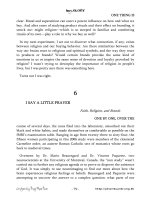a little rundown on brew
Bạn đang xem bản rút gọn của tài liệu. Xem và tải ngay bản đầy đủ của tài liệu tại đây (38.26 KB, 4 trang )
Historically hops, yeast, malted barley, and water have all played
the greatest and most important role in society. For almost 8000 years
these ingredients have been mixed and have been appreciated by all
classes of society in almost all civilizations. The old cliche ³accident is
the mother of invention² is a phrase that definitely holds true in the world
of beer. The discovery was made way back when the Mediterranean
region was the seat of civilization and barley flourished as a dietary
staple. The climate of the Mediterranean was perfect for the cultivation of
barley, and was used as the primary ingredient in breads, cakes, and
other common food products. A farmer during this period discovered that
if barley become wet, germinates, and eventually dried, the resulting
barley would be sweeter and would not be as perishable as the original
state of the barley. There is not any first hand knowledge on how beer
was discovered, but we can imagine the incident step by step. When the
farmer discovered that his barley crop was wet, in order for him to
salvage the crop, he probably spread it out to dry in the sun. Chances
are that germination had already begun, and the grain had therefore
malted and developed a much sweeter taste. The sweet result of what
the farmer considered a disaster is now modern-day malted barley. This
malted barley gave a sweeter taste to breads, cakes, or anything which
had previously been prepared with unmalted barley. After a while when
barley malt became a common ingredient it is thought that a loaf or bowl
of this malt was accidentally left in the rain. When wet, the dissolved
starches and sugars in the malted barley became susceptible to wild
yeast, which started spontaneous fermentation (5). The discoverer of this
new mix probably tasted it and realized how good it was. Unbeknownst
to this ancient farmer, he had brewed the first beer ever. Sumerian
clay tablets dating from 6000 B.C. contain the first ever written recipes for
beer. The tablets also detail specific religious rituals that one had to
perform before he could consume the beverage. The Sumerians also left
the first record of bureaucratic interference when their governments taxed
and put tariffs on beer distribution. Some anthropologists say
that ancient strains of grain were not really good for making bread. Early
wheat made heavy, pasty dough. Flour made from barley made crumbly,
lousy bread. It was determined that humankind¹s first agricultural activity
was growing barley. Forty percent of the grain harvest in Sumeria was
converted to ale. The laws pertaining to beer in ancient times were
very strict. The Code of Hammurrabi in Babylon proved to be more harsh
than our laws today. Establishments that sold beer receive special
mention in those laws, codified in 1800 B.C. Owners of beer parlors who
overcharged customers were sentenced to death by drowning. Those
who failed to notify authorities of criminal elements in their establishments
were also executed (1). Many of the beer makers and bartenders in the
ancient world were women who sold ale under the supervision of the
goddess Ninkasi, ³the lady who fills the mouth.² These Babylonians
brewed at least sixteen styles of beer with wheat and malted barley.
Egyptians paid their workers with jugs of beer, and Ramses II was
said to have consecrated over half a million jugs of it to the gods. In the
Nile region beer was flavored with lavender, date, cedar, nutmeg, sugar,
and probably hops. The bible¹s references to unleavened bread suggest
that the isolation and deliberate use of yeast was known at the time of
Moses. A professor even wrote that beer is mentioned in the book of
Exodus as one of the unknown leavens, and when Moses told Jews to
avoid leavened bread during Passover in Exodus 12, he also meant that
they should avoid beer. King David of the Jews was a brewer, and in
early days of Christianity the Jews carried on the art of brewing and often
introduced it to many other cultures. The classical Greeks and
Romans learned the art of brewing from the Egyptians. The word beer
comes from the Latin ³bibere² meaning simply ³to drink.² The Latin word
for beer is ³cerevisia,² a composite of ³Ceres,² the goddess of agriculture,
and ³vis,² Latin for ³strength.² Beer was carried by many barbarian
tribes in Western and Northern Europe, and by the nineteenth century,
hops was cultivated for brewing purposes in France and Germany. Even
though hops give beer is refreshing properties it was neglected by many
countries for centuries. Instead beers were flavored with woodruff,
juniper, or grenadine, and can still be found in some European beers
today. In the Renaissance period brewing was mostly done by
kings and monks. Home brew was the drink of mostly lower classes. It
wasn¹t uncommon for children to drink beer on a daily basis. The
fermentation process was very useful to destroy many malignant
microorganisms in the distinctly undrinkable waters of most villages (7).
As the reformation came around, the church spent more time on
religious matters than on brewing. At this time commercial brewers
started to pick up the slack and were licensed under kings, queens,
dukes, and earls. During this time queen Elizabeth I had a brew so
strong that none of her servants could handle it, even though they
received two gallons per day. The New World exploration began and
Elizabeth oversaw that no ship left port without a large cargo of beer.
Beer provided a clean supply of water, some food value, and a good
protection against scurvy, the lack of Vitamin C. Another extraordinary
example of beer¹s influence on history is the case of the Pilgrims. They
had first proposed to sail to Virginia but were forced to land at Cape Cod
instead because they were running low on beer. When the Pilgrims
arrived they saw the the Indians too had discovered their own beer made
of maize, rather than barley. The Indians had learned the art of brewing
from their Aztec and Mayan neighbors. Beer was being brewed by Dutch
settlers in New Amsterdam as early as 1612. Harvard College ran a
brewhouse on campus in 1674, and the Harvard¹s first president was
ousted because he failed to supply enough beer and food rations (5).
Beer was valued so high in the Colonial economy that Harvard students
were allowed to pay school tuition in wheat and malted barley. Students
were rationed two pints of beer a day until the end of the 1700s when
they stopped brewing. Many of the Statesmen had a love for beer.
William Penn had a malt house and a brewery on his estate in Bucks
County, Pennsylvania. Samuel Adams had the same set-up in
Massachusetts. Benjamin Franklin kept very accurate records of his
household expenses which allowed orders of twenty gallons of beer per
month. George Washington developed his own recipes for the beer and
made thirty gallons of beer at a time. Thomas Jefferson built his own
brewery at Monticello in 1813 and maintained it until his death in 1826.
His beer was considered by many to be some of the best in the young
country. In the 1800s a boom of breweries swept across the nation.
In 1810 there were 132 breweries in the United States. By 1850 there
were 431 breweries, and by 1860 there were 1,269 breweries. New York
and Pennsylvania dominated the industry, brewing eighty-five percent of
the country¹s beer. During the mid-1800s, millions of immigrants were
pouring into the United States from Europe. Many of these new
Americans bringing along their art and science of brewing lager beer.
Lager is made with a different kind of yeast than ale. They ferment
at the bottom of the barrel and have a drier, cleaner finish than ales.
Lagers provide a clearer brew that is less prone to sour in the days before
refrigerators. But lagers needed to be stored for weeks, or even months,
in cold caves where low temperatures helped mature the beer. The
mid-nineteenth century brought the discovery of the refrigerator, allowing
lagers to be made virtually everywhere. Louis Pasteur¹s studies of yeast
cultures and fermentation help brewers brew lagers on more of a
scientific level in the united States. He discovered the efficiency of
heating liquids after they were packed in a bottle in order to prevent
microbial contamination (5). The process, called pasteurization, was
discovered by Louis because he was trying to preserve beer- not, as most
believe, milk. The lager-brewing breakthrough, coupled with a new wave
of German immigration, produced a golden age of brewing in America.
Between 1870 and 1919 American brewers rivaled their European
counterparts in both quality and quantity of beer products. By 1890 there
were seventy-four breweries clustered in Philadelphia alone,
seventy-seven in New York City, and thirty-eight in Brooklyn. This was
not just an East Coast phenomenon either. Chicago had forty-one
breweries, Cincinnati, twenty-four, Buffalo, twenty, and St. Louis,
twenty-nine. Milwaukee was an important brewing center in the upper
Midwest, and San Francisco, with twenty-six breweries, was the brewing
capitol of the Pacific Coast. This explosion of breweries gave beer
drinkers a wide variety of beers to choose from. On July 1, 1919 the
18th Amendment to the United States Constitution went into effect. Know
as prohibition, the law forbade the manufacture or sale of any beverage
with more than one-half percent alcohol. Throughout the days of
Prohibition, some breweries managed to stay in business selling soda
water, ice cream, and malt beverages. Others took advantage of
gangsters and corruptible police officials to keep production going. Many
breweries survived prohibition by selling malt syrup, which works quite
nicely for home brew. Flavor, taste, and appeal do matter, but with
thousands of breweries shutting their doors, quantity, rather than quality,
became what really mattered. When Prohibition was repealed by the
19th Amendment in 1932, the entire face of the brewing industry had
forever changed. The beer can was introduced in 1935, America
entered a new era of brewing. The can was lightweight, no deposit, no
return container that could be shipped anywhere. Radio, and later
television, meant national advertising on a scale unheard of before. Beer
became a national product instead of a local one. By 1940 there were
over six hundred breweries nationwide. By 1980 that number had
dwindled to forty. The beer renaissance got its start in 1978 in the
United States Congress. That is when the lawmakers legalized beer
making at home. When Prohibition ended in 1933, Congress intended to
legalize the home brewing of both wine and beer. Homemade wine was
legalized, but the stenographer¹s omission left the words ³and/or beer²
out of the Federal register (1). Home brewing of beer was technically
illegal forty-seven years after Prohibition ended. Jimmy Carter erased
that glitch with the stroke of his pen in February 1979. Now it is legal for
every adult in a household to brew one hundred gallons of beer a year.
Today the the American Homebrewers Association counts twenty-seven
thousand members, and their numbers are growing drastically. Now
the microbrewery industry is in its second decade, and the number of
breweries in America has jumped from eighty to almost five hundred in
less than 10 years. The microbreweries are doing great and are here to
stay. In 1992 sales for microbreweries have increased more than 44
percent. In 1993 the story was quite the same when sales increased yet
another 40 percent. Recently Becks beer has done some brewing
experiments aboard the space shuttle to study zero gravity brewing. So
you can bet that by the time we take our vacation to the moon we will
have a beer waiting for us there. Beer has been through a lot in its over
8000 years on this earth, and by the looks of the beer market it may
continue to be one of the oldest beverages in the world.









